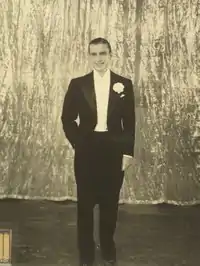Mário Reis (singer)
Mário da Silveira Meireles Reis (31 December 1907 – 5 October 1981 in Rio de Janeiro), also known as Bacharel do Samba was a popular Brazilian samba singer, active between 1928 and 1971. He collaborated with artists such as Francisco Alves, Carmen Miranda, Aracy de Almeida and Noel Rosa and was particularly successful as a radio singer.[1]
Mário Reis | |
|---|---|
 Mário Reis in Hello, Hello, Carnival!, 1936 | |
| Background information | |
| Birth name | Mário da Silveira Meireles Reis |
| Born | December 31, 1907 |
| Origin | Rio de Janeiro, Brazil |
| Died | October 5, 1981 (aged 73) |
| Genres | Samba, marchinha |
| Occupation(s) | Songwriter, singer |
| Instruments | Singer |
| Years active | 1928–1971 |
Biography
He graduated in Law and Social Sciences in the Federal University of Rio de Janeiro Faculty of Law, attending the same classes of Ary Barroso (LLB, 1929).[2]
He recorded many hits with Carmen Miranda and Francisco Alves, with whom also performed frequently in the 1930s, all of which are regarded as amongst the finest Brazilian singers of this period.[3] He toured in Brazil and also Argentina.
As a singer, he was known for his gentle tone, which compensated for the lack of vocal power. His singing style even today sounds modern and he is considered one of the pioneers of bossa nova.[4] Many believe his singing influenced João Gilberto.
He spent many years away from singing career and returned years later to make records. In 1965 and 1971 he recorded two albums, this being his last.
In 1995, Julio Bressane made a film called The Mandarin about the Brazilian popular music of the 20th century, focusing especially on the life and work of Mário Reis. The singer was played by actor Fernando Eiras.
Recordings
- Agora é cinza, Bide e Marçal (1933)
- Alô, alô, André Filho, com Carmen Miranda (1933)
- A razão dá-se a quem tem, Francisco Alves, Ismael Silva e Noel Rosa (1932)
- A tua vida é um segredo, Lamartine Babo (1932)
- Cadê Mimi?, Alberto Ribeiro e João de Barro (1935)
- Chegou a hora da fogueira, Lamartine Babo, com Carmen Miranda (1933).
- Dorinha, meu amor, Freitinhas (1928)
- Eva querida, Benedito Lacerda e Luiz Vassalo (1934)
- Filosofia, André Filho e Noel Rosa (1933)
- Fita amarela, Noel Rosa, com Francisco Alves (1932)
- Formosa, J. Rui e Nássara (1932)
- Gosto que me enrosco, Sinhô (1929)
- Isto é lá com Santo Antônio, Lamartine Babo, com Carmen Miranda (1934)
- Joujoux e balangandãs, Lamartine Babo, com Mariah (1939)
- Jura, Sinhô (1928)
- Linda morena, Lamartine Babo (1932)
- Mulato bamba, Noel Rosa (1932)
- Nem é bom falar, Francisco Alves, Ismael Silva e Nilton Bastos (1931)
- O que será de mim?, Francisco Alves, Ismael Silva e Nilton Bastos, com Francisco Alves (1931)
- Quando o samba acabou, Noel Rosa (1933)
- Rasguei a minha fantasia, Lamartine Babo (1934)
- Ride, palhaço, Lamartine Babo (1933)
- Se você jurar, Francisco Alves, Ismael Silva e Nilton Bastos, com Francisco Alves (1931)
- Sofrer é da vida, Francisco Alves, Ismael Silva e Nilton Bastos (1932)
- Uma andorinha não faz verão, João de Barro e Lamartine Babo (1933)
References
- McCann, Bryan (January 2004). Hello, hello Brazil: popular music in the making of modern Brazil. Duke University Press. p. 59. ISBN 978-0-8223-3273-2. Retrieved 7 June 2011.
- Souza, Tárik de (2003). Tem mais samba: das raízes à eletrônica. Editora 34. p. 55. ISBN 978-85-7326-287-2. Retrieved 7 June 2011.
- Crook, Larry (September 2005). Brazilian music: northeastern traditions and the heartbeat of a modern nation. ABC-CLIO. p. 249. ISBN 978-1-57607-287-5. Retrieved 7 June 2011.
- Silva, Walter (2002). Vou te contar: histórias de música popular brasileira. Conex. pp. 198–. ISBN 978-85-88953-05-5. Retrieved 7 June 2011.
Literature
- ALBIN, Ricardo Cravo (Criação e Supervisão Geral). Dicionário Houaiss Ilustrado da Música Popular Brasileira. Rio de Janeiro: Paracatu, 2006.
- MORAIS JUNIOR, Luis Carlos de. O Sol nasceu pra todos:a História Secreta do Samba. Rio de Janeiro: Litteris, 2011.